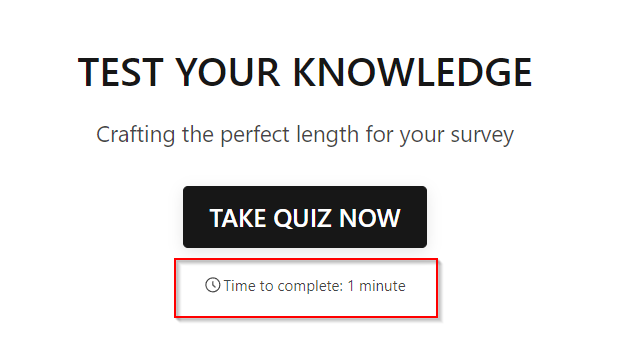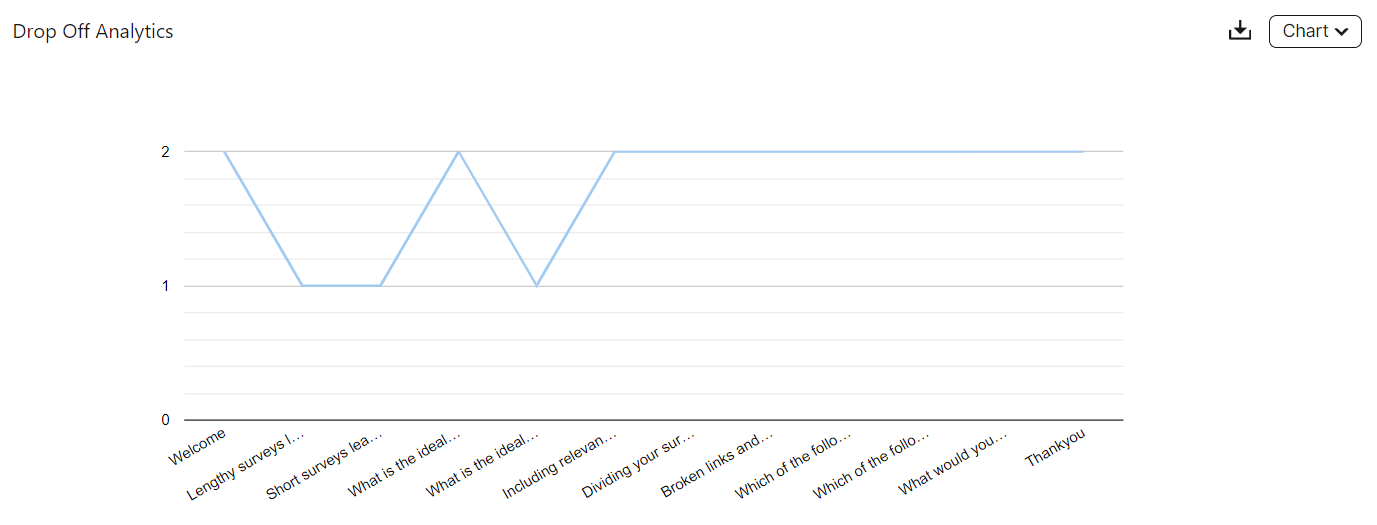Get insights.
Unlock value.
- 14-day free trial
- Set up in minutes
- No credit card required
Crafting the Ideal Length for your survey
What You’ll Learn
By the end of this lesson, you’ll be able to:
- Understand the importance of ideal survey length.
- Identify the optimal survey length for different surveys.
- Implement Strategies to counteract survey length.
1. The Importance Of Survey Length
Survey length is a very important factor to consider when crafting your survey.
Lengthy surveys can tire respondents, leading to speedy or thoughtless answers. Every new question you add increases the chance of the respondent abandoning the survey midway.
On the other hand, studies have shown that shorter surveys generally have higher completion rates. But it's important to balance length with the depth of information needed.
It'd be great if you prioritize your survey's purpose so you can decide which questions are essential and which can be removed. Every question should have a clear purpose that aligns with the survey's goals.
Redundant or vague questions only extend the survey without adding value.
A well-crafted survey with the ideal length can increase response rates, improve data quality, and provide valuable insights that inform decision-making.
As a rule of thumb, aim to strike the right balance of length and depth of questions to craft the ideal survey.
2. Optimal Length Of Surveys
Different surveys serve different purposes. Based on the purpose of the survey, the length of the survey also varies.
Short polls are ideal for quick feedback. Short polls are very handy for faster data collection and higher completion rates. These short polls often have questions ranging from 1 to 5.
Customer feedback forms are usually targeted towards customers, focusing on recent interactions. This type of survey is usually short to medium-length. This means 5 to 10 questions would be ideal for customer feedback data collection.
Employee engagement surveys are organizational. They are typically longer, with 10 to 15 questions, gauging various aspects of an employee's experience within the organization. Also, this type of survey is required to be anonymous in the best interest of employees.
Research surveys aim to get deep insights from the respondents. This type of survey has more open-ended questions. This research survey can be longer and aims to collect detailed data. They usually contain 15 to 20 questions or more.
| Survey Type | Ideal number of questions |
|---|---|
| Short polls | 1 - 5 |
| Customer Feedback Forms | 5 - 10 |
| Employee Engagement Surveys | 10 - 15 |
| Research Surveys | 15 - 20 and more |
Now that you have a sense of the optimal length for different surveys, you can craft the ideal number of questions next time when you create surveys.
3. Survey Design Strategies to Counteract Length
In this section, you'll find a few design aspects that make surveys feel short.
3.1. Engaging Visuals
When you include relevant images, infographics, or other visuals, it keeps respondents engaged. Visual elements aren't just aesthetic enhancements. They can help explain a point, making it easier for respondents to understand and answer their surveys.
3.2. Various Question Types
When your survey contains various **question types like multiple choice, sliders, checkboxes, and open text fields, it can keep things interesting. This variety ensures the respondent isn't stuck in a monotonous answering pattern. This technique stops survey fatigue & rushed answers.
3.3. User Interface
Clean layouts, clear fonts, and Intuitive UI/UX can make a long survey seem short. Ensure balanced use of white space so the survey doesn’t look cluttered. Also, consider breaking up sections with different background colors or separators. While using colors for sections, ensure that the color matches the purpose of the survey.
3.4. Divided Surveys
Dividing your survey into distinct sections is a sure way to make a long survey feel shorter. Progress indicators can motivate respondents to complete the survey, giving them an idea of how long they must go.
3.5. Time to Complete
BlockSurvey has Time to Complete on the welcome screen. This is especially helpful because it provides the time to complete the survey even before starting it. You can find the "Time to Complete" field in the screenshot below.

3.6. Average Completion Time
BlockSurvey provides the option to view the Average Completion Time in the response analytics. The average completion time can help you craft your future surveys better. It helps you receive insights. You can find the "Average Completion Time" field in the screenshot below.

3.7. Drop Off Analytics
It is always great to find out which question in the survey triggers more drop-off. BlockSurvey Analytics provides you with the Drop Off Analytics feature. This chart can vividly tell you at which question in the survey drop-offs have occurred. By knowing drop off, you can refrain from using similar questions in your future surveys (you can also edit and republish the same survey). You can find the Drop Off Analytics screenshot below.

4. Technical Considerations
4.1 Mobile Optimization
With more users accessing surveys on mobile devices rather than desktops, make sure that your survey is mobile-optimized.
A lengthy survey on a desktop might feel even longer on mobile if respondents have to keep scrolling.
4.2 Faster Loading Times
Nothing stops respondents more than a slow-loading survey. Make sure your platform can handle the multimedia elements without glitches or lag.
When you embed videos or use high-resolution images, compress them but retain quality without compromising speed.
4.3 Ensure User Experience
From start to finish, the user experience should be smooth. Broken links, unresponsive buttons, or issues with saving responses can be frustrating.
You can regularly test your surveys on different devices and browsers to ensure consistency.
5. Breaking Complexity
Survey questions can range from straightforward closed-ended ones, like multiple-choice, to detailed open-ended questions that demand detailed responses. The former can be answered quickly, while the latter requires time for reflection.
For instance, the question,
"Are you satisfied with our service?"
can be answered faster than the question,
"What improvements would you suggest for our service?".
While detailed responses are valuable, deciding on the time commitment you're asking from respondents is important.
If your survey is loaded with open-ended questions, consider changing them with quicker, closed-ended ones like rating scales. This approach breaks the monotony while taking surveys and also ensures participants aren’t overwhelmed.
6. Providing Incentives
The Power of Incentives should not be underestimated while running longer surveys.
According to research, the average survey response rate falls around 10% to 30%. People are hesitant about taking surveys, and survey incentives are the extra push they need to complete the survey. By providing incentives, you acknowledge that people’s time is valuable.
Providing Incentives means saying, “We value your time and opinion. So here’s our token of appreciation for your effort.”.
Long surveys demand more time, and offering incentives can be a compelling way to encourage completion.
The incentives could range from monetary incentives like discounts and gift cards to non-monetary incentives like entry into a prize draw or access to premium products.
It's crucial to understand that incentives can sometimes skew survey results, especially if respondents rush through just to receive the reward. Hence, while designing your survey, ensure that there are checks to measure genuine responses.
7. Feedback Collection
Before sending out your survey to the broader audience, test it with a smaller group. This test group can provide valuable feedback on your survey's length and difficulty. Moreover, pilot testing can give you an estimate of the average completion time.
Receiving feedback can help you attain the correct survey length and improve survey quality.
During the pilot test, provide a section at the end of the survey for participants to share their experiences.
Including the following questions can offer invaluable insights.
"Did you ever find this survey too long to complete?"
"Were there any questions you found redundant?"
"What specific suggestions do you have for improvement?”
"Is there anything else you would like to share about your experience?”
If multiple respondents felt a section was too lengthy or complex, consider correcting it in future surveys. Use the feedback to continuously refine your surveys.
Test Your Knowledge
Crafting the Ideal Length for your survey FAQ
What is the ideal length for a survey?
The ideal length for a survey depends on the complexity of the topic and target audience, but generally, keeping it concise and focused is recommended.
How long should my survey be to ensure participants' engagement?
Shorter surveys tend to have higher participant engagement rates, so aim for a length that can be completed within 5-10 minutes.
Does the length of a survey affect the quality of the data collected?
Yes, longer surveys often lead to participant fatigue and decreased response quality. Keeping surveys shorter helps maintain data accuracy.
Are there any guidelines for the number of questions in a survey?
While there are no strict rules, it's advisable to limit your survey to around 10-15 questions to maintain participant interest and ensure data reliability.
Can I include more questions to gather extensive data?
Including additional questions can be tempting, but it's crucial to balance survey needs with participant experience to avoid dropouts and incomplete responses.
Get insights.
Unlock value.
- 14-day free trial
- Set up in minutes
- No credit card required
